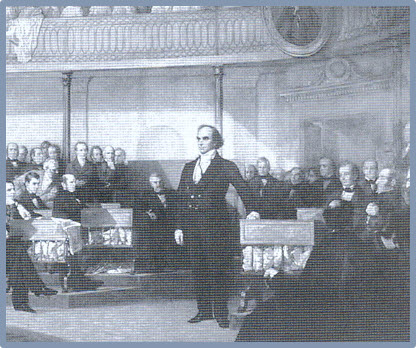 ANDREW JACKSON AND
THE PRESIDENCY: PART 1
ANDREW JACKSON AND
THE PRESIDENCY: PART 1
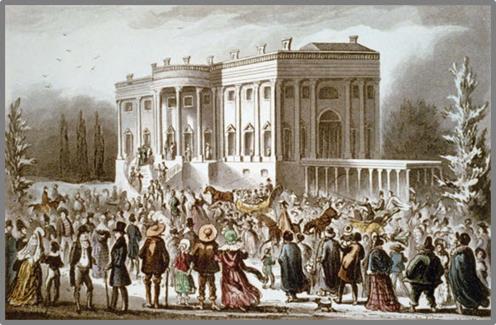
Drawing of the
Scene at the White House after Jackson's First Inaugural: The Playfair Papers, 1841
Unit
Overview
The
election of 1824 proved that the Era of Good Feelings was over. Although Andrew Jackson won the popular vote,
he did not receive the majority required by the Electoral College. This left the decision of who would be
president up to the House of Representatives.
When members of the House chose John Quincy Adams, Jackson was
furious. With the help of Martin Van
Buren, he formed the Democratic Party which carried him to victory in
1828. Jackson brought a new style to the
White House and based his decisions on his definition of democracy. Let’s see how it all happened.
The
Controversial Election of 1824
By
the time James Monroe finished his second term, the Federalist Party had all
but disappeared, and most Americans considered themselves Republicans. There were, however, differences among the
various groups within the party, and four candidates for the presidential
election of 1824 emerged from the three major sections of the country. Although they all called themselves
Republicans, each one had a different opinion on the role of the federal
government. Let’s meet the candidates!

·
Henry Clay: Henry Clay, Speaker of the House of
Representatives and a congressmen from Kentucky, called for a federally funded
program of internal improvements, including roads and canals. According to Clay, this would improve and
increase the exchange of western farm products for eastern manufactured
goods. He favored a national banking
system and supported high tariffs on imported goods to protect American
manufacturers. Henry Clay called his economic
plans the American System and was a
favorite of some western voters.
·
John Quincy Adams: John Quincy Adams, son of former President
John Adams, received the support of the merchants and factory owners throughout
the northeast. Having served as
President Monroe’s capable secretary of state, Adams had foreign policy
experience and proposed measures that strengthened the country as a whole.
·
Andrew
Jackson: Andrew Jackson
briefly served his home state of Tennessee in the House of Representatives and
the Senate, but he was not a Washington career-politician. Born in the Carolina back country in 1767,
Jackson was raised in poverty and was an orphan at age fourteen. He eventually became a wealthy planter and
slave-owner. Unlike the other candidates
in the election of 1824, Andrew Jackson was not just a sectional hero but a
national one as result of his success in the Battle of New Orleans. He refused to take a stand on most issues during
the campaign, because he did not want to risk losing votes.
·
John C. Calhoun: John C. Calhoun had served as a congressman,
vice president, secretary of war and secretary of state. Once a nationalist, he became a strong
supporter of states’ rights by the 1820s.
He opposed high tariffs and claimed that the only protected the
inefficiency of manufacturers. Because
most southerners supported Crawford, Calhoun dropped out of the race for
president and ran for vice president.
Since he was the only candidate for that office, he was assured a
victory.
·
William Crawford: William Crawford, a former congressman from
Georgia and secretary of the treasury during the Monroe administration, was the
nominee of the Republican Party. Former
Presidents Jefferson, Madison and Monroe supported his candidacy. Although Crawford was well-known throughout
the South, he suffered a stroke, and his ill-health limited his ability to
conduct a convincing campaign.
When
voters cast their ballots, Andrew Jackson received the largest number of
popular votes. However, he did not have
a majority of the electoral votes
required by the Constitution. Therefore,
the House of Representatives had to decide who would be the next
president. You can see the number of
electoral votes each candidates received on the map below. The gray areas represent parts of the country
that were territories but not yet states.
According to the Constitution, the three candidates with the most
electoral votes were to be presented to the House. They were Jackson, Adams and Crawford. Clay finished fourth and was out of the
presidential race. The remaining
candidates knew that Henry Clay still had the power to influence congressmen because
he was Speaker of the House of Representatives.
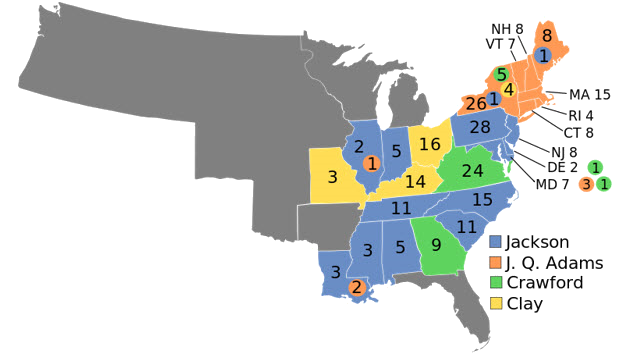
Distribution of the Electoral Votes: Presidential Election of 1824
Each
candidate sent a delegation to earn Henry Clay’s support. The Jackson people made a strong case. Old
Hickory, as he was nicknamed, had been the people’s choice and had received
the largest number of electoral votes.
William Crawford’s team had little to present since their candidate’s
health had not improved. John Quincy
Adams, on the other hand, remained a serious challenger. Adams won Clay’s backing because he supported
Clay’s American System. John Quincy
Adams was chosen as president by the House of Representatives on February 9,
1825.
 Go to Questions 1 through 3.
Go to Questions 1 through 3.
Plotting
Revenge
Following
his inauguration, President Adams appointed his Cabinet and named Henry Clay as
secretary of state. Andrew Jackson,
furious over losing the election, was convinced that this confirmed a secret
deal between Adams and Clay. Although
there was no evidence to support this claim, Jackson went home to Tennessee and
began to plan a strategy to make it very difficult for the new administration
to accomplish anything. Take a quick
tour of the Hermitage, Andrew
Jackson’s home, by clicking on the graphic below.
With
the help of Senator Martin Van Buren
from New York, Jackson organized strong opposition in Congress against any
legislation proposed by President Adams.
This made John Quincy Adams appear to be a very weak president. At the same time, Jackson and his followers
organized a new political party, the Democratic
Party. With Jackson as their leader,
the Democrats appealed to those who were unhappy with Adams and the National Republicans, the new name for
members of the Republican Party. As the
election of 1828 approached, the National Republicans and the Democrats
prepared for a tough campaign.
 Go to Questions 4 and 5.
Go to Questions 4 and 5.
The
Election of 1828
Most
Americans expected both parties to engage in plenty of mudslinging during the
presidential election campaign of 1828, and they were not disappointed. There were vicious attacks on the character
and background of each candidate. John Quincy Adams ran for a second term
as the National Republican nominee with Richard
Rush as the vice presidential contender.
The Democrats relied on state conventions or state legislatures rather
than caucuses to choose their candidates.
Andrew Jackson was the
Democratic choice for president, and John
C. Calhoun ran for vice president after joining the Democratic Party. When the votes were counted, Jackson won 56%
of the popular vote and a clear majority in the Electoral College as noted on
the map pictured below. John Quincy
Adam’s reaction was similar to that of his father when he lost the election of
1800. He left Washington D.C. shortly
after midnight on his last day in office and refused to attend the inauguration
of President Jackson.
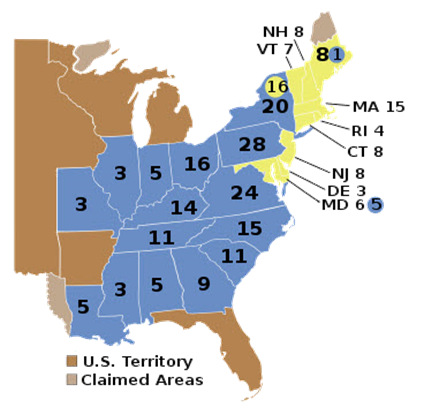
Distribution of Electoral Votes: Presidential Election of 1828
 Go to Questions 6 through 8.
Go to Questions 6 through 8.
Jackson’s
Presidential Style
Throughout
his presidential campaign, Andrew Jackson referred to himself as the champion
of the common man. He stressed his life
story, frontier experience and military career rather than political
issues. Because most states no longer
listed the ownership of property as a voting requirement, the number of white
males participating in presidential elections increased from 27% to 58% by 1828. This meant that many Americans, including
sharecroppers, factory workers and farm hands, voted for the first time in the
elections held during the 1820s. Many of
these people saw as Andrew Jackson their president. Westerners, in particular, were overjoyed when
Jackson won the presidency. For the
first time, Americans had chosen a chief executive who was not from Virginia or
Massachusetts. Settlers in the West saw
Jackson as someone who cared about them and understood their problems.
On
March 4, 1829, President-elect Andrew Jackson made his way on foot down
Pennsylvania Avenue to his inaugural ceremony at the U.S. Capitol. Thousands of people lined the route to cheer
his accomplishment. After one of the
shortest inaugural addresses in United States’ history, Jackson made his way to
the White House. Following a custom
started by Thomas Jefferson, Jackson’s followers had planned to hold an open
house for his supporters. An
enthusiastic crowd of common people, who had come to shake hands with their
president, circled the White House.
Because there were no guards to provide security, they made their way
indoors. The throng around Andrew
Jackson was so great that his friends had to protect him from injury. Socialite Mary Smith was a frequent guest at
White House social functions. Read her
description of the event quoted in the graphic below.

Once
Jackson took office, he was determined to reward the people who helped him win
the election. He planned to accomplish
this by hiring them as federal workers. To
create these positions, Jackson fired 20% of those who were employed by the
national government. Then, the President
replaced them with loyal friends, members of the Democratic Party and financial
contributors to his campaign. Jackson
insisted that it was more democratic to change people in government service
periodically. Although his opponents
argued that it was unfair not to choose the person best qualified for the job,
the President’s system remained in effect.
The policy of rewarding loyal political supporters with government jobs
became known as the spoils system. The term was derived from the following
phrase used by Senator William L. Marcy to describe Jackson’s policy: To the victors (winners) belong the spoils
(rewards)! The spoils system continued
to be a source of controversy long after Jackson left office. This cartoon picturing Jackson on a pig, a
symbol of greed, is an example of the strong opinions generated by the practice.

Figure 1Cartoon
Critical of Jackson and the Spoils System:
Thomas Nast
Like
previous presidents, Andrew Jackson appointed members to his Cabinet. Unlike his predecessors, he did not usually
rely on or meet with them. When he
needed advice, Jackson talked things over with trusted friends and business
associates. They often sat around a table in the White House kitchen during
their discussions. Jackson’s critics
called the group the Kitchen Cabinet
and complained about its influence on presidential decisions. Andrew Jackson’s strong will and commanding
presence, however, left little doubt as to who was in charge of the executive
branch. During his eight years in
office, President Jackson made his share of enemies but remained popular by
appealing directly to the people for support.
He also vetoed more bills passed by Congress than all the other previous
presidents put together.
![]() Go to Questions 9 through 14.
Go to Questions 9 through 14.
The
Tariff of Abominations
The
Early
in Jackson’s presidency, a major disagreement developed between the sections of
the country concerning tariffs. At
first, tariffs generated money to run the government and to pay the national
debt. After 1816, Congress passed
several protective tariffs to help
American industries. The taxes usually
made imported products more expensive than those manufactured in the United
States. This helped American industry to
grow and to be competitive. Because most
factories were located in the North, that section of the country strongly
supported this policy. Southerners,
however, questioned its benefits to the country as a whole.
In
1828, the controversy over tariffs intensified.
Congress passed and President John Quincy Adams signed a new protective
tariff law that increased taxes on imported goods to a new high. Manufacturers in the northeast were happy
with the legislation, but it angered planters throughout the South. They argued that it forced all Americans to
pay higher prices. Southerners also
feared that European nations would retaliate with tariffs of their own on
cotton. Decreased sales of cotton abroad
meant less money for plantation owners.
To emphasize just how much they hated this law, people throughout the
South referred to it as the Tariff of
Abominations. In South Carolina,
there was talk of leaving the Union.
 Go to Questions 15 and 16.
Go to Questions 15 and 16.
The
Nullification Crisis
South
Carolina planters were determined to fight the tariff, and they turned to the
state’s most powerful politician, Vice President John C. Calhoun, for help.
This placed Calhoun in a difficult position. He knew that Andrew Jackson would enforce the
tariff because it was a federal law. At
the same time, he did not want to lose the support of South Carolinians. Therefore, Calhoun tried to find a way for
South Carolina to avoid obeying the law.
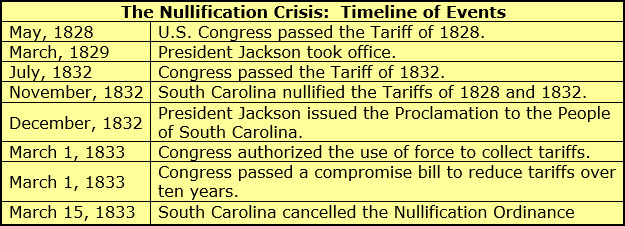
Vice
President Calhoun argued that a state or a group of states had the right to
cancel, or to nullify, a federal law
if it was in the state’s best interest.
He reasoned that the Union existed because the states had voluntarily
agreed to give up some of their authority.
If a law passed by Congress gave the national government powers not
specifically mentioned in the Constitution, a state could legally nullify
it. In other words, the law did not have
to be obeyed within that state. To deny
this right to the states was dangerous, Calhoun noted, because, without it, the
federal government could easily abuse its authority. This made perfect sense to southerners, who
viewed the Tariff of 1828 as a law that deserved to be nullified.
Calhoun’s
theory of nullification caused heated debates in Congress over states’
rights. One of the most famous exchanges
took place in the United States Senate in January of 1830. Robert
Hayne, a young senator from South Carolina, defended the right of a state
to nullify a federal law and concluded that a state also had the right to
leave, or to secede, from the
Union. Daniel Webster, representing Massachusetts in the Senate, responded
by delivering a dramatic speech that emphasize the importance of the Union and
the Constitution. Southerners hoped that
President Jackson would side with them, but Jackson made it clear that, during
his presidency, the Union would be preserved.
Vice President Calhoun knew that Jackson would not change his mind. After resigning as vice president, Calhoun was
elected to represent South Carolina as a U.S. Senator.
An Artist's Rendition
of Daniel Webster during the Debate
Anger
over the tariff continued to escalate throughout the South. In July of 1832, Congress passed a new, lower
tariff law, but it did little to improve the situation. South Carolina passed the Order of Nullification, which declared
that the Tariff of 1828 and the Tariff of 1832 would not be observed in the
state. Some South Carolinians suggested
that the state should leave the Union. This
resulted in a stern response from President Jackson, who was determined to
enforce the federal law as he was sworn to do.
First, he alerted the army to prepare 50,000 soldiers to enforce the
tariff laws in South Carolina. Then, he
issued the Proclamation to the People of
South Carolina. As you can see from
reading the excerpt below, Andrew Jackson made it very clear that South
Carolinians would pay a high price if they chose to ignore federal law.
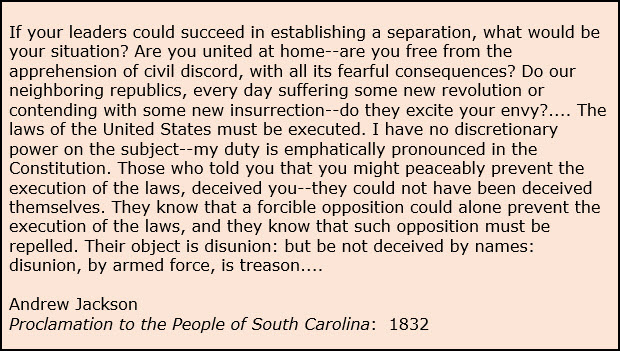
Although
the proclamation was issued, President Jackson worked behind the scenes to
resolve the crisis. He met with the
congressional leaders of the Democratic Party and asked them to help write a
tariff bill that would be acceptable to southerners. With the assistance of Henry Clay and his ability to encourage compromise, Congress passed
a new tariff law in 1833. It gradually
lowered taxes on imports for the next ten years. Jackson wanted to make sure that South
Carolina would accept Clay’s compromise.
For this reason, he convinced Congress to pass the Force Act, which permitted the president to use the United States
military to enforce laws established by Congress. On March 15, 1833, South Carolina removed the
Nullification Ordinance. In the long
term, however, this did not end southern interest in succession or narrow the
gap between the North and the South. Radicals
in South Carolina realized that they would need the support of other states if
they were going to challenge the federal government. They also learned that the federal government
would not permit states to leave the Union without a fight.
![]() Go to Questions 17 through 25.
Go to Questions 17 through 25.
What
Happened Next?
The
Nullification Crisis was only one of the controversies that erupted during the
Jackson administration. As the United
States expanded westward, settlers on the frontier demanded that Native
Americans be relocated. President
Jackson, a frontiersman himself, supported their position. This led to the Indian Removal Act and Native
American resistance. Jackson also became
involved in another political battle when he vetoed the bill to renew the
Second Bank of the United States. In the
next unit, you will see how these issues affected Jackson’s presidency and
power of the executive branch. Before
moving on, review the names and terms in Unit 23; then, complete Questions 26
through 35.
 Go to Questions 26 through 35.
Go to Questions 26 through 35.
 |
| Unit 24 Presidential Profile: John Quincy Adams Article and Quiz |
| Unit 24 Presidential Profile: John Quincy Adams Writing Exercise |
| Unit 24 What's the Big Idea? Worksheet |

